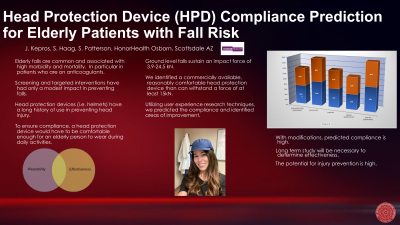Trauma
Category: Quickshot Oral Session 24
Quickshot Oral : Quickshot Oral Session 24
COMPLIANCE PREDICTION OF A NOVEL HEAD PROTECTION DEVICE FOR ELDERLY PATIENTS AT RISK FOR FALLS
Tuesday, February 14, 2023
7:00am - 8:00am East Coast USA Time


John P. Kepros, MD (he/him/his)
Trauma Medical Director
HonorHealth, Arizona, United States- SH
Susan Haag, PhD
Trauma Research Director
HonorHealth, United States
Presenter(s)
Principal Contact(s)
Objectives: Ground level falls (GLF) in the elderly are common and can result in significant brain injury often related to anticoagulant and antiplatelet medications. Risk screening and targeted interventions to prevent falls have been minimally effective prompting us to instead focus on preventing injury due to a fall. We identified a head injury protection (HPD) device that meets head impact criteria sustained in a GLF and is aesthetically pleasing. HPDs, such as helmets, have a long and validated use in preventing head injury in industrial or sport-related activities, yet they have not been studied for normal daily activity.
Methods: This single-center user experience (UXE) case study investigated the wearability and acceptance of the HPD from patient perspectives to predict future compliance. 12 elderly head-injured trauma patients were provided a HPD to wear in the hospital while ambulatory. Clinical, demographic, and UXE data from a 6-factor assessment captured HPD interaction (experience), ease of use, comfort, weight, user recommendation, and intent to wear the HPD in specific home contexts. Descriptive statistics analyzed patient demographics; frequencies and percentages were recorded for categorical variables. Chi-squared tests calculated differences between categorical variables (sex, age group1, 52-73 years; group2, 74+) regarding compliance.
Results: Median age was 74 (52-89), 58% were female, 75% on anticoagulants, and all had GLFs; hospital LOS (ED + ADMIT) was 3.4 days. 83% had previous falls. UXE data show 100% wore the HPD in hospital, 83% intend to wear the HPD at home; 50% will recommend the HPD; 58% were satisfied; 83% indicated ease of use and comfort (58%); only 42% felt weight was appropriate and modifications were warranted for extended wear. 50% would always wear the HPD when walking; 42% would wear the HPD shopping. Chi Squared analysis showed no differences in compliance with both sex and gender.
Conclusion: Targeted interventions to limit morbidity and mortality in elderly fall patients, such as this current HPD, could be implemented early to help protect the brain in the event of a fall. Usability and acceptance of HPDs are fundamental to ease the adoption of assistive devices in the elderly. A protective cap is likely to have a reasonably high compliance in a population at risk for GLFs if only adopting a few of the modifications identified. This short-term UXE case provides important preliminary data about HPD wearability and compliance that will inform an anticipated larger, longitudinal trial.
Methods: This single-center user experience (UXE) case study investigated the wearability and acceptance of the HPD from patient perspectives to predict future compliance. 12 elderly head-injured trauma patients were provided a HPD to wear in the hospital while ambulatory. Clinical, demographic, and UXE data from a 6-factor assessment captured HPD interaction (experience), ease of use, comfort, weight, user recommendation, and intent to wear the HPD in specific home contexts. Descriptive statistics analyzed patient demographics; frequencies and percentages were recorded for categorical variables. Chi-squared tests calculated differences between categorical variables (sex, age group1, 52-73 years; group2, 74+) regarding compliance.
Results: Median age was 74 (52-89), 58% were female, 75% on anticoagulants, and all had GLFs; hospital LOS (ED + ADMIT) was 3.4 days. 83% had previous falls. UXE data show 100% wore the HPD in hospital, 83% intend to wear the HPD at home; 50% will recommend the HPD; 58% were satisfied; 83% indicated ease of use and comfort (58%); only 42% felt weight was appropriate and modifications were warranted for extended wear. 50% would always wear the HPD when walking; 42% would wear the HPD shopping. Chi Squared analysis showed no differences in compliance with both sex and gender.
Conclusion: Targeted interventions to limit morbidity and mortality in elderly fall patients, such as this current HPD, could be implemented early to help protect the brain in the event of a fall. Usability and acceptance of HPDs are fundamental to ease the adoption of assistive devices in the elderly. A protective cap is likely to have a reasonably high compliance in a population at risk for GLFs if only adopting a few of the modifications identified. This short-term UXE case provides important preliminary data about HPD wearability and compliance that will inform an anticipated larger, longitudinal trial.

